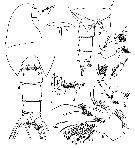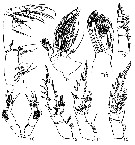|
|
 |
Fiche d'espèce de Copépode |
|
|
Calanoida ( Ordre ) |
|
|
|
Clausocalanoidea ( Superfamille ) |
|
|
|
Phaennidae ( Famille ) |
|
|
|
Xanthocalanus ( Genre ) |
|
|
| |
Xanthocalanus quasiprofundus Vyshkvartzeva, 2002 (F) | |
| | | | | | | Ref.: | | | Vyshkvartzeva, 2002 (p.91, figs.F) |  Issued from : N.V. Vyshkvartzeva in Zoosyst. Rossica , St. Petersburg, 2002, 11. [p.92, Figs.1-8]. Female (from 85°54'6''N, 47°02'4''W): 1, forehead (lateral); 2, rostrum (ventral); 3, 5th thoracic segment with P5 and urosome (right side); 4, sema (ventral view); 5, A2; 6, Md (masticatory edge of gnathobase); 7, Md palp; 8, Mx1. Nota: - Cephalosome and 1st pedigerous segment fused, 4th and 5th thoracic segments fused, but thin articulation sutures visible. - Rostrum as a short plate with 2 long delicate filaments posteriad. - Urosome as long as 1/4 of prosome.
- Urosome in proportional length 39 : 21 : 18 : 9 : 10 = 100.
Urosomal segments 1-3 striated along posterior margin.
- Caudal rami as long as wide; inner margin with long setules; dorsal (S7) and ventral (S2) setae absent.
- Genital segment 1.3 times as long as wide, laterally without genital swelling, with a tuft of setules near genital opening (fig.3). Transverse genital opening and comparatively small operculum located just before midlength of genital segment. Spermatheca elongate; lateralm triangular skeletal plates well developed. Paired copulatory pores lie behind genital opening (fig.4).
- A1 24-segmented, reaching posterior margin of urosomal segment 1.
- A2 endopod about 0.75 times as long as exopod 6-segmented.exopodal segments 1-6 with 0, 1, 1, 1, 1, 0+3 setae, respectively.
- Md: gnathobase with 10 teeth and 1 slender dorsal spinulose seta; there are spinules of various sizes along bases of central teeth; 3 ventral teeth much higher than the rest, with multicusped crowns; 2 central teeth unicusped; 2 other central and 3 dorsal teeth bicusped; one tip of dorsalmost tooth remarkably elongate. Basis with 3 long inner setae; endopod as long as exopod; endopodal segment 1 with 2, endopodal segment 2 with 9 setae.
-Mx1: inner lobe 1 with 9 marginal, 4 posterior (S11-S14) and 1 anterior (S6) setae, length of marginal setae remarkably increase distally; inner lobe 2 with 2 long and 1 short setae; inner lobe 3 with 2 long and 2 shorter setae; inner lobe 4 with 3 long, 2 shorter and 1 small setae; endopodal segment 1 fused with basis, with 3 setae; endopodal segment 2 fused with the 1st, with 2 setae; 3rd endopodal segment with 4 setae; exopod with 10 and outer lobe 1 with 9 setae.
|
 Issued from : N.V. Vyshkvartzeva in Zoosyst. Rossica , St. Petersburg, 2002, 11. [p.93, Figs.9-16]. Female: 9, Mx2; 10, Mx2 distal endopodal complex; 11, Mxp; 12, P1; 13, P2; 14, P3; 15, P4; 16, P5. Nota: - Mx2 compact; inner lobes 1-3 short, subequal; inner lobe 1 with 5 setae (4 long plumose and 1 shorter and thinner); inner lobe 2 with 2 long plumose and 1 shorter but more coarsely plumose setae; inner lobe 3 with 1 long, plumose seta, 1 short, coarsely plumose seta, and short, worm-like sensory seta; inner lobe 4 with 1 long plumose seta, 1 shorter and more coarsely plumose seta and 1 more strongly sclerotized long seta tapering distally, with long, strong, dense spinules; inner lobe 5 with 2 strong claw-like setae( 1 plumose and 1 with very strong spinules) and 2 worm-like setae, of which one is tapering and seems only partly transformed; endopod indistinctly 4-segmented; endopodal segments 1-3 each bearing 2 brush-like sensory setae; one brush-like seta on endopodal segment 3 much shorter and thicker, with apical brush formed of numerous long setules; endopodal segment 4 with 1 brush-like and 1 worm-like sensory seta (distal part of worm-like seta seems to be missing). - Mxp syncoxa with 1 plumose seta and 2 worm-like setae proximally, the latter with setular rows along their length; with 1 seta and 1 brush-like sensory seta medially; with 3 plumose setae subterminally and patch of minute spinules terminally; basis slightly longer than syncoxa, bearing patch of minute spinules proximally and 3 plumose setae medially; endopod as long as 2/3 of basis, with 2+4, 4, 4, 3, 3+1 outer and 4 terminal setae, respectively; one of the setae on each endopodal segments 1-3 stout, spinulose, with scythe-shaped terminal part. - P5 uniramous, 3-segmented; proximal segment on inner margin with row of small spinules proximally and short thickened spinules distally; 2nd segment twice as long as wide and slightly longer than distal segment, with patch of long lancet-like spinules along distal half of outer margin; distal segment 2.2 times as long as wide, its posterior surface with long spinules plus group of shorter spinules distally, terminally there are 4 serrate spines (2 apical, inner slightly longer than outer, one, the longest, inner, and one outer spine as long as 2/3 of inner and situated opposite to inner spine.
| | | | | NZ: | 1 | | |
|
Carte de distribution de Xanthocalanus quasiprofundus par zones géographiques
|
| | | | Loc: | | | Arctic (Nansen Basin) | | | | N: | 1 | | | | Lg.: | | | (878) F: 7,6; {F: 7,60} | | | | Rem.: | ? Bathypélagique
Voir aussi les remarques en anglais | | | Dernière mise à jour : 12/03/2015 | |
|
|
 Toute utilisation de ce site pour une publication sera mentionnée avec la référence suivante : Toute utilisation de ce site pour une publication sera mentionnée avec la référence suivante :
Razouls C., Desreumaux N., Kouwenberg J. et de Bovée F., 2005-2025. - Biodiversité des Copépodes planctoniques marins (morphologie, répartition géographique et données biologiques). Sorbonne Université, CNRS. Disponible sur http://copepodes.obs-banyuls.fr [Accédé le 23 août 2025] © copyright 2005-2025 Sorbonne Université, CNRS
|
|
 |
 |





